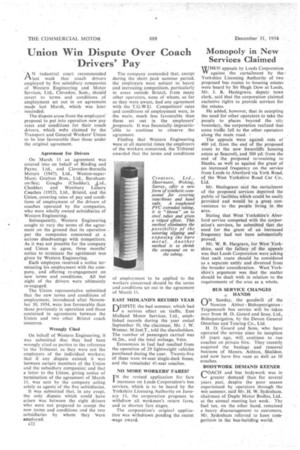Monopoly in New Services Claimed
Page 24

If you've noticed an error in this article please click here to report it so we can fix it.
WHEN appeals by Leeds Corporation vy against the curtailment by the, Yorkshire Licensing Authority of two proposed bus routes to housing estates were heard by Sir Hugh Dow at Leeds, Mr. J. R. Haslegrave, deputy town clerk, said that the corporation clairned exclusive rights to provide services for the estates.
He added, however, that in accepting the need for other operators to take the people to places beyond• the city boundary, the corporation realized that some traffic fell to -the other operators along the main road.
The appeals were againil cuts or 400 yd. from the end of the proposed route to the new Swarcliffe housing estate at Seacroft, and 300 yd. from the end of the proposed re-routeing to Stanks, as well as against the grant of an increased frequency on the service from Leeds to Aberford via York Road, of the West Yorkshire Road Car Co., Ltd.
Mr. Haslegrave said the curtailment of the proposed services deprived the public of facilities which could be easily provided and would be a great convenience to the people living in the area.
Stating that West Yorkshire's Aberford service competed with the corporation's services, he submitted that the need for the grant of an increased frequency had not been substantially proved.
Mr. W. R. Hargrave, for West Yorkshire, said the fallacy of the appeals was that Leeds Corporation were asking that each route should be considered as a separate entity and divorced from the broader consideration. West Yorkshire's argument was that the matter should be dealt with in relation to the requirements of the area as a whole.












































































